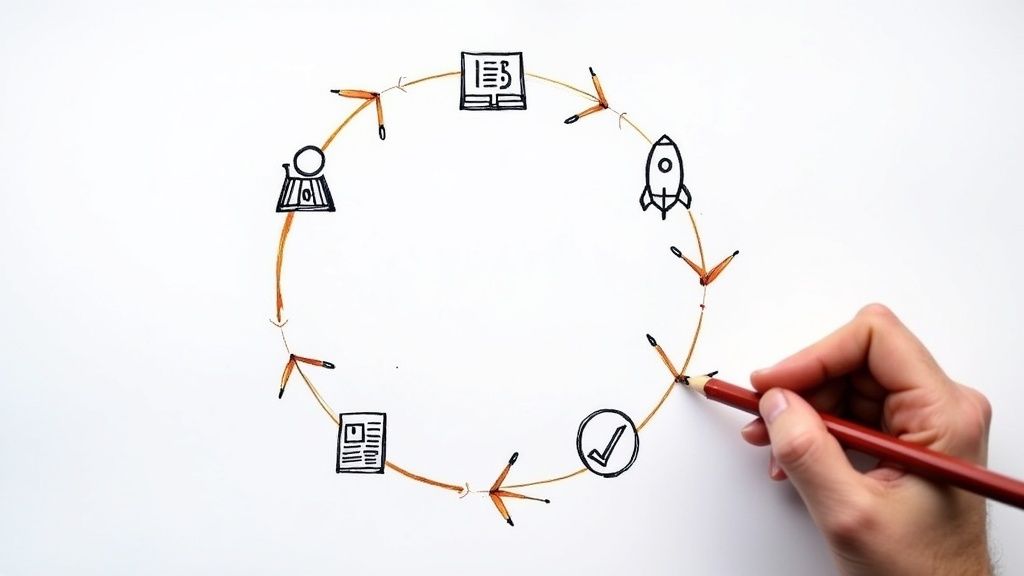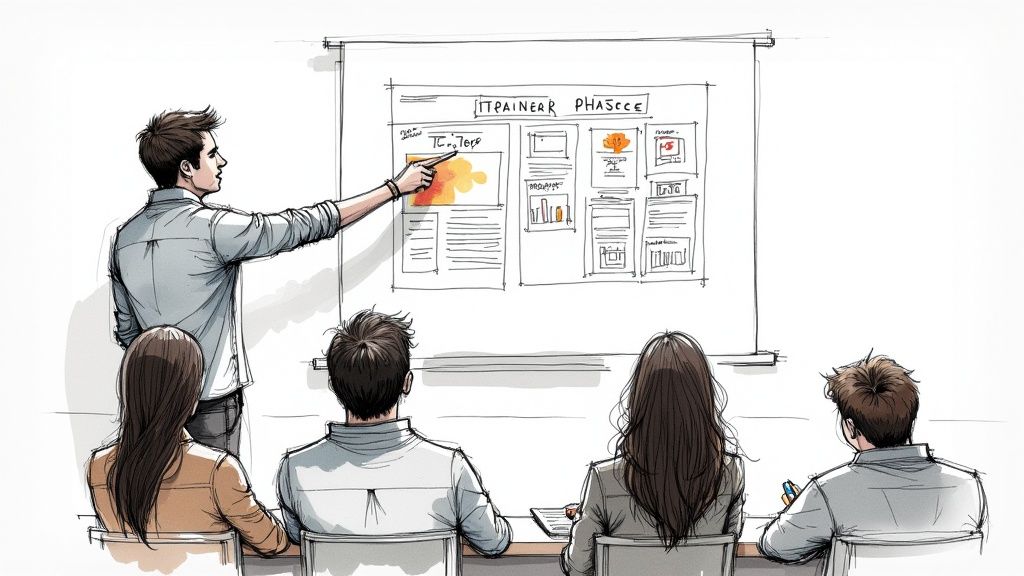
The ADDIE model is a classic for a reason. It's a five-phase roadmap—Analysis, Design, Development, Implementation, and Evaluation—that gives instructional designers a reliable structure for building training that actually works. Think of it as a systematic way to make sure your training is focused, hits the right audience, and delivers measurable results. It’s a true cornerstone of our field.
With all the talk about AI, microlearning, and lightning-fast development, you might wonder if a framework like ADDIE is still relevant. The answer is a resounding yes. It’s not about rigid rules; it’s a flexible playbook that keeps projects grounded and prevents them from spiraling into chaos. At its core, ADDIE helps us build learning experiences that solve real business problems.
First developed for the U.S. Army nearly five decades ago, ADDIE has become the global standard for a reason. Its systematic approach forces you to align every decision with both learner needs and business goals.
Modern instructional design is packed with amazing tech. We have AI to crunch learner data, powerful authoring tools like the Articulate Suite to build interactive content, and Learning Experience Platforms (LXP) to serve up personalized learning paths.
ADDIE doesn’t get in the way of these tools—it gives them a purpose.
I like to think of ADDIE as the architectural blueprint for a house. You can use all the latest power tools and smart-home gadgets you want, but you still need that blueprint to make sure the foundation is solid and the walls don't fall over.
Before we dive deeper, here’s a quick overview of what each phase is all about.
This structured process is one of the biggest benefits of eLearning, because it ensures every video, quiz, and PDF has a clear purpose. Without a solid framework, it’s all too easy to create training that looks great but accomplishes nothing. ADDIE provides the discipline needed to make sure technology serves learning, not the other way around.
Every great training program starts with a single mission: solving a real-world problem. And that journey begins right here, in the Analysis phase. Think of this as your detective work. Before you ever dream of creating a single slide or video, your job is to uncover the true performance gaps.
It's tempting to blast out a generic survey and call it a day, but that's a recipe for vague, useless data. The real insights come from targeted needs assessments and, more importantly, actual conversations. I’ve found that sitting down with key stakeholders—managers, top performers, and even the folks who are struggling—gives you a much clearer, richer picture of the challenges they're facing.
Your main goal here is to figure out if you’re dealing with a "can't do" problem or a "won't do" problem. It's a crucial distinction. Is the sales team missing its targets because they don't understand the new product specs (a knowledge gap)? Or is it because the new commission structure killed their motivation (an incentive issue)? Training is a fantastic fix for the first problem, but it won't do a thing for the second.
This is where you have to dig in, look at the data, and start checking things off your list to get to the heart of the matter.

As you can see, analysis isn't a single action. It’s about combining different investigative methods—poring over documents, evaluating performance data, and systematically running through requirements—to zero in on the root cause.
The most expensive training program is the one that solves the wrong problem. Spending extra time in the Analysis phase saves immense resources down the line by ensuring you're building a solution that will actually deliver results.
Once you have that clear picture, you can finally write learning objectives that are crystal clear and measurable. These objectives become the bedrock of your entire training program and are fundamental to all solid instructional design principles.
To keep things moving and avoid getting stuck in "analysis paralysis," here are a few practical tips I've learned to live by:
Alright, you've done the detective work in the analysis phase. You know what the problem is. Now, it's time to put on your architect's hat. The Design phase is all about creating the blueprint for your entire learning experience. This is where we make sure every single piece has a purpose and fits together perfectly to create something powerful.
Honestly, this is my favorite part of the whole ADDIE process. It’s where creativity really comes into play. You’re making all the big decisions about the structure, the flow, and the overall vibe of your training. You'll map out the entire learning journey, outline the modules, and figure out the best way to actually teach the material to hit your objectives.

This is also where we get into storyboarding and prototyping. A storyboard is basically a visual outline for your course—think of it like a comic strip. It maps out exactly what your learners will see, hear, and do from one screen to the next. Trust me, spending time on this now saves a massive amount of headaches and rework later in development.
One of the most important calls you'll make right now is choosing the right delivery method. A one-size-fits-all approach is a recipe for failure. Your choice needs to directly support the learning objectives you figured out back in the analysis phase.
Let's look at a few scenarios:
Every choice you make in this phase has to be intentional. Don't add a game just because it's the cool thing to do. Add it because you know it will motivate your specific audience to practice a key skill. The goal is always engagement with a purpose.
Finally, let's talk about assessments. It's time to move beyond the simple multiple-choice quizzes that just test if someone was paying attention. Our goal is to measure how well learners can actually apply what they've learned back on the job.
So, get creative. Think about building practical, scenario-based questions. Or maybe small projects that mimic the tasks they'll actually be doing. This approach gives you a much more accurate picture of learning and, just as importantly, reinforces how relevant the training is to their day-to-day work.
By the time you wrap up the design phase, you should have a detailed blueprint in hand. It will outline all your content, activities, and assessments, all perfectly aligned with your original goals. Now, you’re ready to start building.
Alright, you've got your detailed blueprint from the design phase. Now it's time to roll up your sleeves and actually build the thing. The Development phase is where all your hard work planning finally becomes a tangible training experience. This is the production stage—you're creating the content, recording the videos, and building the activities your learners will dive into.
This part of the process is a fun mix of creativity and technical know-how. You'll spend most of your time in authoring tools, working closely with your SMEs to bring the storyboards and outlines to life. It’s less about big-picture strategy and more about pure execution. Let's get building.
Gone are the days of just making PowerPoint decks. Today's instructional designers have an incredible toolbox for creating engaging learning experiences. The right tool really depends on what you're trying to build, how fast you need it, and the kind of interaction you're aiming for.
When you're starting out, it's easy to get overwhelmed by the options. I've found it's best to think about the end product first. Are you making a quick, mobile-friendly guide? Or a complex, branching simulation? The answer will point you to the right software.
Here’s a quick look at some of the tools I use most often and what they're best for:
Choosing a tool is a big decision, but don't let it paralyze you. Start with what you need for the project in front of you. You can always learn a new tool later as your projects get more complex. The goal is to get your content built and into the hands of learners.
I see so many new designers get bogged down trying to create Hollywood-level videos or overly complicated graphics. Remember: the goal is clarity and effectiveness, not winning a design award. A simple, well-produced job aid or a clean eLearning module almost always beats a flashy but confusing animation.
Once your materials are created, you need a way to deliver them. This is where your learning platform comes in.
A traditional Learning Management System (LMS) is the workhorse for many corporate training departments. It’s fantastic for assigning mandatory courses, tracking completions for compliance, and running reports. Think of it as the administrator's command center.
On the other hand, a lot of companies are moving toward a Learning Experience Platform (LXP). An LXP is like a "Netflix for learning." It often uses AI to suggest content from all over—your courses, articles, videos—based on an employee's role and skills. This encourages a "pull" learning culture where people actively seek out knowledge for their own growth.
Regardless of your platform, the final step before launch is crucial: QA testing.
Before you go live, package your course (usually in a SCORM file) and upload it for a small pilot group. These testers are your safety net. They'll catch the typos, broken links, and confusing instructions you've become blind to after staring at the project for weeks. It’s a simple step that makes the difference between a frustrating learner experience and a smooth, professional rollout.
After all the groundwork of analysis, design, and development, it's finally go-time. The Implementation phase is where the rubber meets the road—where your meticulously planned training program actually gets into the hands of your learners. A great launch is so much more than just hitting "publish" on your Learning Management System (LMS). It’s a coordinated rollout that primes everyone for success.
This is the moment of truth for your ADDIE model training project. Your main job now is to make sure the delivery is smooth, positive, and effective. Think of yourself as a launch manager, checking every last detail before the big day.

A seamless implementation all comes down to preparation. I always, always start with a pilot test. Grab a small, friendly group of test learners and let them run through everything. You're not just looking for typos here; you're testing the entire user experience. Do all the links work? Is the navigation actually intuitive? Does the course crash on a tablet? Their feedback is gold for ironing out the kinks before you go live.
Once the course itself is solid, it's time to prep the people. And I don't just mean the learners. Their managers and any facilitators are just as crucial.
A classic rookie mistake is getting so focused on the content that you forget the context. A well-planned launch that brings managers into the loop and clearly communicates the value will skyrocket learner engagement.
The space where learning happens—whether physical or digital—is just as important as the content. For online courses on an LMS or a Learning Experience Platform (LXP), this means having technical support on standby. Make it crystal clear who learners should contact if they hit a snag.
For in-person or virtual workshops, it's all about psychological safety. You have to create an atmosphere where people feel comfortable asking questions, participating in discussions, and even making a few mistakes. This is the bedrock of effective skill-building, which we dive into more in our guide to a competency-based training approach.
When you nail both the technical and human side of implementation, your training doesn’t just launch—it makes a real, lasting impact.
So, after all that hard work—the planning, designing, and building—we get to the big question: Did the training actually stick? This is the moment of truth, the Evaluation phase. It’s where we figure out if we solved the problem we uncovered way back in the beginning.
Frankly, this is the step that separates great training from just "going through the motions."
A lot of programs stop with what we call "smile sheets." You know the ones—those quick surveys asking if people enjoyed the session. While it's nice to know people didn't fall asleep, that feedback tells you almost nothing about whether they learned anything or will do their jobs differently. To see real impact, you have to go deeper.
A classic, and still incredibly useful, framework for this is the Kirkpatrick Model. It gives you four distinct levels to measure, each one providing a clearer picture of your training's success.
Hitting Level 4 is how you prove the real ROI of your work. It directly connects your training program to the company's bottom line and shows everyone that what you're doing provides serious value.
Evaluation isn't just about giving yourself a grade and moving on. The insights you gather here are gold, and they feed directly back into the beginning of the process for the next round.
Maybe you find out a particular module was confusing. Or a simulation was too simple. That's not a failure; it's critical data that helps you make the next version even better. This is what turns ADDIE from a linear checklist into a powerful, living cycle of continuous improvement.
Now, ADDIE has its critics. Some argue its step-by-step nature can be too slow for the fast pace of modern business. In fact, about 80% of global training professionals agree that the model needs to be more flexible. You can read more about how instructional designers are adapting ADDIE for today's needs.
That’s precisely why a strong evaluation is non-negotiable. When you treat this phase as an ongoing feedback loop instead of a final report, you give the classic model the agility it needs to keep up. You create training that doesn't just get done—it gets better, every single time.
Even the most straightforward framework comes with its own set of "what ifs" and "how abouts" when you start applying it to real-world projects. Let's tackle some of the most common questions I hear from people who are just getting their feet wet with the ADDIE model training process.
I get this one a lot. People picture a long, waterfall-style process that takes months before anyone sees anything. And sure, if you follow it strictly by the old-school book, it can be.
But that’s not how modern instructional designers work. We’ve adapted. Think of it more like "agile ADDIE." Instead of waiting until the end, we create quick prototypes during the Design and Development phases. We'll build out one small module, get it in front of a few learners, gather feedback, and tweak it on the fly.
This approach means you're doing mini-evaluations all along the way, not one massive one at the very end. It keeps the project nimble and ensures you don't spend six months building something nobody actually likes or needs. It’s all about being flexible, not dogmatic.
It's easy to get these two confused, but they serve pretty different purposes.
A Learning Management System (LMS) is your command center. It’s a top-down tool where an administrator pushes out required training. Think compliance modules, new hire onboarding, and formal certification paths. The business is in the driver's seat.
A Learning Experience Platform (LXP), on the other hand, puts the learner in control. It feels more like Netflix or Spotify for learning. It often uses AI to pull content from all over the place—internal wikis, external articles, videos, courses—and recommends things based on your skills, career goals, and interests.
An LMS is for the training the company needs you to take. An LXP is for the learning you want to do.
Many companies end up using both to create a really well-rounded learning ecosystem.
Absolutely. Don't let the five stages fool you into thinking it's only for massive projects. The ADDIE framework is incredibly scalable, which makes it perfect for creating bite-sized microlearning content.
The process just gets a lot faster and leaner:
Using the framework ensures that even your smallest learning assets are focused, purposeful, and actually solve a problem.
Ready to build or refresh your eLearning content with a proven, modern approach? At Relevant Training, we specialize in creating effective learning experiences for businesses of all sizes. Visit our website to learn how we can help.